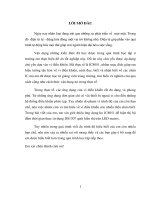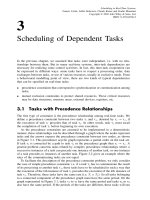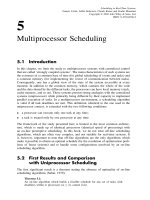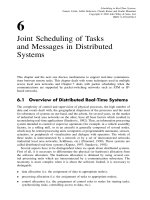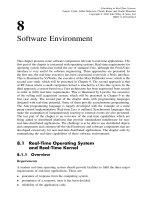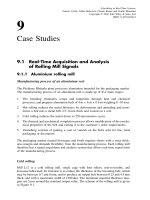Lịch khai giảng trong các hệ thống thời gian thực P2
Bạn đang xem bản rút gọn của tài liệu. Xem và tải ngay bản đầy đủ của tài liệu tại đây (759.4 KB, 28 trang )
2
Scheduling of Independent Tasks
This chapter deals with scheduling algorithms for independent tasks. The first part of
this chapter describes four basic algorithms: rate monotonic, inverse deadline, earliest
deadline first, and least laxity first. These algorithms deal with homogeneous sets
of tasks, where tasks are either periodic or aperiodic. However, real-time applications
often require both types of tasks. In this context, periodic tasks usually have hard timing
constraints and are scheduled with one of the four basic algorithms. Aperiodic tasks
have either soft or hard timing constraints. The second part of this chapter describes
scheduling algorithms for such hybrid task sets.
There are two classes of scheduling algorithms:
• Off-line scheduling algorithms: a scheduling algorithm is used off-line if it is exe-
cuted on the entire task set before actual task activation. The schedule generated
in this way is stored in a table and later executed by a dispatcher. The task set
has to be fixed and known apriori, so that all task activations can be calculated
off-line. The main advantage of this approach is that the run-time overhead is low
and does not depend on the complexity of the scheduling algorithm used to build
the schedule. However, the system is quite inflexible to environmental changes.
• On-line scheduling: a scheduling algorithm is used on-line if scheduling decisions
are taken at run-time every time a new task enters the system or when a running
task terminates. With on-line scheduling algorithms, each task is assigned a pri-
ority, according to one of its temporal parameters. These priorities can be either
fixed priorities, based on fixed parameters and assigned to the tasks before their
activation, or dynamic priorities, based on dynamic parameters that may change
during system evolution. When the task set is fixed, task activations and worst-case
computation times are known apriori, and a schedulability test can be executed
off-line. However, when task activations are not known, an on-line guarantee test
has to be done every time a new task enters the system. The aim of this guarantee
test is to detect possible missed deadlines.
This chapter deals only with on-line scheduling algorithms.
2.1 Basic On-Line Algorithms for Periodic Tasks
Basic on-line algorithms are designed with a simple rule that assigns priorities accord-
ing to temporal parameters of tasks. If the considered parameter is fixed, i.e. request
Scheduling in Real-Time Systems.
Francis Cottet, Jo¨elle Delacroix, Claude Kaiser and Zoubir Mammeri
Copyright
2002 John Wiley & Sons, Ltd.
ISBN: 0-470-84766-2
24 2 SCHEDULING OF INDEPENDENT TASKS
rate or deadline, the algorithm is static because the priority is fixed. The priorities are
assigned to tasks before execution and do not change over time. The basic algorithms
with fixed-priority assignment are rate monotonic (Liu and Layland, 1973) and inverse
deadline or deadline monotonic (Leung and Merrill, 1980). On the other hand, if the
scheduling algorithm is based on variable parameters, i.e. absolute task deadlines, it is
said to be dynamic because the priority is variable. The most important algorithms in
this category are earliest deadline first (Liu and Layland, 1973) and least laxity first
(Dhall, 1977; Sorenson, 1974).
The complete study (analysis) of a scheduling algorithm is composed of two parts:
• the optimality of the algorithm in the sense that no other algorithm of the same
class (fixed or variable priority) can schedule a task set that cannot be scheduled
by the studied algorithm.
• the off-line schedulability test associated with this algorithm, allowing a check of
whether a task set is schedulable without building the entire execution sequence
over the scheduling period.
2.1.1 Rate monotonic scheduling
For a set of periodic tasks, assigning the priorities according to the rate monotonic (RM)
algorithm means that tasks with shorter periods (higher request rates) get higher
priorities.
Optimality of the rate monotonic algorithm
As we cannot analyse all the relationships among all the release times of a task set, we
have to identify the worst-case combination of release times in term of schedulability
of the task set. This case occurs when all the tasks are released simultaneously. In fact,
this case corresponds to the critical instant, defined as the time at which the release
of a task will produce the largest response time of this task (Buttazzo, 1997; Liu and
Layland, 1973).
As a consequence, if a task set is schedulable at the critical instant of each one of
its tasks, then the same task set is schedulable with arbitrary arrival times. This fact is
illustrated in Figure 2.1. We consider two periodic tasks with the following parameters
τ
1
(r
1
,1,4,4)andτ
2
(0, 10, 14, 14). According to the RM algorithm, task τ
1
has high
priority. Task τ
2
is regularly delayed by the interference of the successive instances of
the high priority task τ
1
. The analysis of the response time of task τ
2
as a function of
the release time r
1
of task τ
1
shows that it increases when the release times of tasks
are closer and closer:
• if r
1
= 4, the response time of task τ
2
is equal to 12;
• if r
1
= 2, the response time of task τ
2
is equal to 13 (the same response time holds
when r
1
= 3andr
1
= 1);
• if r
1
= r
2
= 0, the response time of task τ
2
is equal to 14.
2.1 BASIC ON-LINE ALGORITHMS FOR PERIODIC TASKS 25
τ
1
t
τ
2
t
Response time = 12
τ
1
t
τ
2
t
Response time = 13
τ
1
t
τ
2
t
Response time = 14
Figure 2.1 Analysis of the response time of task
τ
2
(0, 10, 14, 14) as a function of the release
time of task
τ
1
(r
1
, 1, 4, 4)
In this context, we want to prove the optimality of the RM priority assignment algo-
rithm. We first demonstrate the optimality property for two tasks and then we generalize
this result for an arbitrary set of n tasks.
Let us consider the case of scheduling two tasks τ
1
and τ
2
with T
1
<T
2
and their
relative deadlines equal to their periods (D
1
= T
1
, D
2
= T
2
). If the priorities are not
assigned according to the RM algorithm, then the priority of task τ
2
may be higher
than that of task τ
1
. Let us consider the case where task τ
2
has a priority higher than
that of τ
1
. At time T
1
,taskτ
1
must be completed. As its priority is the low one, task
τ
2
has been completed before. As shown in Figure 2.2, the following inequality must
be satisfied:
C
1
+ C
2
≤ T
1
(2.1)
Now consider that the priorities are assigned according to the RM algorithm. Task
τ
1
will receive the high priority and task τ
2
the low one. In this situation, we have to
distinguish two cases in order to analyse precisely the interference of these two tasks
t
C
1
C
2
t
T
1
T
2
Figure 2.2 Execution sequence with two tasks
τ
1
and
τ
2
with the priority of task
τ
2
higher
than that of task
τ
1
26 2 SCHEDULING OF INDEPENDENT TASKS
t
1
2
T
1
T
2
Case 1
t
t
1
2
T
2
Case 2
t
T
1
T
2
Figure 2.3 Execution sequence with two tasks
τ
1
and
τ
2
with the priority of task
τ
1
higher
than that of task
τ
2
(RM priority assignment)
(Figure 2.3). β =
T
2
/T
1
is the number of periods of task τ
1
entirely included in the
period of task τ
2
. The first case (case 1) corresponds to a computational time of task
τ
1
which is short enough for all the instances of task τ
1
to complete before the second
request of task τ
2
.Thatis:
C
1
≤ T
2
− β · T
1
(2.2)
In case 1, as shown in Figure 2.3, the maximum of the execution time of task τ
2
is
given by:
C
2,max
= T
2
− (β + 1) · C
1
(2.3)
That can be rewritten as follows:
C
2
+ (β + 1) · C
1
≤ T
2
(2.4)
The second case (case 2) corresponds to a computational time of task τ
1
which is large
enough for the last request of task τ
1
not to be completed before the second request
of task τ
2
.Thatis:
C
1
≥ T
2
− β · T
1
(2.5)
In case 2, as shown in Figure 2.3, the maximum of the execution time of task τ
2
is
given by:
C
2,max
= β · (T
1
− C
1
)(2.6)
That can be rewritten as follows:
β · C
1
+ C
2
≤ β · T
1
(2.7)
In order to prove the optimality of the RM priority assignment, we have to show
that the inequality (2.1) implies the inequalities (2.4) or (2.7). So we start with the
assumption that C
1
+ C
2
≤ T
1
, demonstrated when the priority assignment is not done
2.1 BASIC ON-LINE ALGORITHMS FOR PERIODIC TASKS 27
according to the RM algorithm. By multiplying both sides of (2.1) by β, we have:
β · C
1
+ β · C
2
≤ β · T
1
Given that β =
T
2
/T
1
is greater than 1 or equal to 1, we obtain:
β · C
1
+ C
2
≤ β · C
1
+ β · C
2
≤ β · T
1
By adding C
1
to each member of this inequality, we get (β + 1) · C
1
+ C
2
≤ β · T
1
+ C
1
.
By using the inequality (2.2) previously demonstrated in case 1, we can write (β +
1) · C
1
+ C
2
≤ T
2
. This result corresponds to the inequality (2.4), so we have proved
the following implication, which demonstrates the optimality of RM priority assignment
in case 1:
C
1
+ C
2
≤ T
1
⇒ (β + 1) · C
1
+ C
2
≤ T
2
(2.8)
In the same manner, starting with the inequality (2.1), we multiply by β each member of
this inequality and use the property β ≥ 1. So we get β · C
1
+ C
2
≤ β · T
1
. This result
corresponds to the inequality (2.7), so we have proved the following implication, which
demonstrates the optimality of RM priority assignment in case 2:
C
1
+ C
2
≤ T
1
⇒ β · C
1
+ C
2
≤ β · T
1
(2.9)
In conclusion, we have proved that, for a set of two tasks τ
1
and τ
2
with T
1
<T
2
with
relative deadlines equal to periods (D
1
= T
1
,D
2
= T
2
),ifthescheduleisfeasibleby
an arbitrary priority assignment, then it is also feasible by applying the RM algorithm.
This result can be extended to a set of n periodic tasks (Buttazzo, 1997; Liu and
Layland, 1973).
Schedulability test of the rate monotonic algorithm
We now study how to calculate the least upper bound U
max
of the processor utilization
factor for the RM algorithm. This bound is first determined for two periodic tasks τ
1
and τ
2
with T
1
<T
2
and again D
1
= T
1
and D
2
= T
2
:
U
max
=
C
1
T
1
+
C
2,max
T
2
In case 1, we consider the maximum execution time of task τ
2
given by the equality
(2.3). So the processor utilization factor, denoted by U
max,1
, is given by:
U
max,1
= 1 −
C
1
T
2
·
(β + 1) −
T
2
T
1
(2.10)
We can observe that the processor utilization factor is monotonically decreasing in C
1
because [(β + 1) − (T
2
/T
1
)] > 0. This function of C
1
goes from C
1
= 0 to the limit
between the two studied cases given by the inequalities (2.2) and (2.5). Figure 2.4
depicts this function.
In case 2, we consider the maximum execution time of task τ
2
given by the equality
(2.6). So the processor utilization factor U
max,2
is given by:
U
max,2
= β ·
T
1
T
2
+
C
1
T
2
·
T
2
T
1
− β
(2.11)
28 2 SCHEDULING OF INDEPENDENT TASKS
U
max,2
U
max,lim
U
max
1
0
C
1
T
1
C
1
= T
2
− T
1
U
max,1
Case 1 Case 2
Schedulability area
Figure 2.4 Analysis of the processor utilization factor function of C
1
We can observe that the processor utilization factor is monotonically increasing in C
1
because [T
2
/T
1
− β] > 0. This function of C
1
goes from the limit between the two
studied cases given by the inequalities (2.2) and (2.5) to C
1
= T
1
. Figure 2.4 depicts
this function.
The intersection between these two lines corresponds to the minimum value of the
maximum processor utilization factor that occurs for C
1
= T
2
− β · T
1
. So we have:
U
max,lim
=
α
2
+ β
α + β
where α = T
2
/T
1
− β with the property 0 ≤ α < 1.
Under this limit U
max,lim
, we can assert that the task set is schedulable. Unfortunately,
this value depends on the parameters α and β. In order to get a couple α, β independent
bound, we have to find the minimum value of this limit. Minimizing U
max,lim
over α,
we have:
dU
max,lim
dα
=
(α
2
+ 2αβ − β)
(α + β)
2
We obtain dU
max,lim
/dα = 0forα
2
+ 2αβ − β = 0, which has an acceptable solution
for α : α =
√
β(1 + β) − β
Thus, the least upper bound is given by U
max,lim
= 2 · [
√
β(1 + β) − β].
For the minimum value of β = 1, we get:
U
max,lim
= 2 · [2
1/2
− 1] ≈ 0.83
And, for any value of β, we get an upper value of 0.83:
∀β,U
max,lim
= 2 ·{[β(1 + β)]
1/2
− β}≤0.83
2.1 BASIC ON-LINE ALGORITHMS FOR PERIODIC TASKS 29
t
t
t
τ
1
τ
3
τ
2
0
02
04579
2571012
1210414
15 17 20
20
20
Figure 2.5 Example of a rate monotonic schedule with three periodic tasks:
τ
1
(0, 3, 20, 20),
τ
2
(0,2,5,5)and
τ
3
(0, 2, 10, 10)
We can generalize this result for an arbitrary set of n periodic tasks, and we get a
sufficient schedulability condition (Buttazzo, 1997; Liu and Layland, 1973).
U =
n
i=1
C
i
T
i
≤ n · (2
1/n
− 1)(2.12)
This upper bound converges to ln(2) = 0.69 for high values of n. A simulation study
shows that for random task sets, the processor utilization bound is 88% (Lehoczky
et al., 1989). Figure 2.5 shows an example of an RM schedule on a set of three periodic
tasks for which the relative deadline is equal to the period: τ
1
(0, 3, 20, 20), τ
2
(0,
2, 5, 5) and τ
3
(0, 2, 10, 10). Task τ
2
has the highest priority and task τ
1
has the
lowest priority. The schedule is given within the major cycle of the task set, which is
the interval [0, 20]. The three tasks meet their deadlines and the processor utilization
factor is 3/20 + 2/5 + 2/10 = 0.75 < 3(2
1/3
− 1) = 0.779.
Due to priority assignment based on the periods of tasks, the RM algorithm should
be used to schedule tasks with relative deadlines equal to periods. This is the case
where the sufficient condition (2.12) can be used. For tasks with relative deadlines not
equal to periods, the inverse deadline algorithm should be used (see Section 2.1.2).
Another example can be studied with a set of three periodic tasks for which the
relative deadline is equal to the period: τ
1
(0, 20, 100, 100), τ
2
(0, 40, 150, 150)
and τ
3
(0, 100, 350, 350). Task τ
1
has the highest priority and task τ
3
has the lowest
priority. The major cycle of the task set is LCM(100, 150, 350) = 2100. The processor
utilization factor is:
20/100 + 40/150 + 100/350 = 0.75 < 3(2
1/3
− 1) = 0.779.
So we can assert that this task set is schedulable; all the three tasks meet their deadlines.
The free time processor is equal to 520 over the major cycle. Although the scheduling
sequence building was not useful, we illustrate this example in the Figure 2.6, but only
over a tiny part of the major cycle.
2.1.2 Inverse deadline (or deadline
monotonic) algorithm
Inverse deadline allows a weakening of the condition which requires equality between
periods and deadlines in static-priority schemes. The inverse deadline algorithm assigns
30 2 SCHEDULING OF INDEPENDENT TASKS
t
τ
1
100 200 300
t
t
τ
2
100 200 300
τ
3
100
200 300
Preemption of task
3
Figure 2.6 Example of a rate monotonic schedule with three periodic tasks:
τ
1
(0, 20, 100,
100),
τ
2
(0, 40, 150, 150) and
τ
3
(0, 100, 350, 350)
priorities to tasks according to their deadlines: the task with the shortest relative
deadline is assigned the highest priority. Inverse deadline is optimal in the class
of fixed-priority assignment algorithms in the sense that if any fixed-priority algo-
rithm can schedule a set of tasks with deadlines shorter than periods, than inverse
deadline will also schedule that task set. The computation given in the previous
section can be extended to the case of two tasks with deadlines shorter than peri-
ods, scheduled with inverse deadline. The proof is very similar and is left to the
reader. For an arbitrary set of n tasks with deadlines shorter than periods, a sufficient
condition is:
n
i=1
C
i
D
i
≤ n(2
1/n
− 1)(2.13)
Figure 2.7 shows an example of an inverse deadline schedule for a set of three peri-
odic tasks: τ
1
(r
0
= 0,C= 3,D= 7,T = 20), τ
2
(r
0
= 0,C= 2,D= 4,T = 5) and
τ
3
(r
0
= 0,C= 2,D= 9,T = 10).Taskτ
2
has the highest priority and task τ
3
the
lowest. Notice that the sufficient condition (2.13) is not satisfied because the processor
load factor is 1.15. However, the task set is schedulable; the schedule is given within
the major cycle of the task set.
4020 9 7 5
t
0 2 0
2 7 5
t
4 0 209 7 5
t
τ
3
(r
0
= 0, C = 2, D = 9, T = 10)
τ
2
(r
0
= 0, C = 2, D = 4, T = 5)
τ
1
(r
0
= 0, C = 3, D = 7, T = 20)
10 12 14 15 17 19
10 12 14 19
Figure 2.7 Inverse deadline schedule
2.1 BASIC ON-LINE ALGORITHMS FOR PERIODIC TASKS 31
2.1.3 Algorithms with dynamic priority assignment
With dynamic priority assignment algorithms, priorities are assigned to tasks based
on dynamic parameters that may change during task execution. The most important
algorithms in this category are earliest deadline first (Liu and Layland, 1973) and least
laxity first (Dhall, 1977; Sorenson, 1974).
Earliest deadline first algorithm
The earliest deadline first (EDF) algorithm assigns priority to tasks according to their
absolute deadline: the task with the earliest deadline will be executed at the highest
priority. This algorithm is optimal in the sense of feasibility: if there exists a feasible
schedule for a task set, then the EDF algorithm is able to find it.
It is important to notice that a necessary and sufficient schedulability condition
exists for periodic tasks with deadlines equal to periods. A set of periodic tasks with
deadlines equal to periods is schedulable with the EDF algorithm if and only if the
processor utilization factor is less than or equal to 1:
n
i=1
C
i
T
i
≤ 1 (2.14)
A hybrid task set is schedulable with the EDF algorithm if (sufficient condition):
n
i=1
C
i
D
i
≤ 1 (2.15)
A necessary condition is given by formula (2.14). The EDF algorithm does not make
any assumption about the periodicity of the tasks; hence it can be used for scheduling
periodic as well as aperiodic tasks.
Figure 2.8 shows an example of an EDF schedule for a set of three periodic tasks
τ
1
(r
0
= 0,C= 3,D= 7, 20 = T), τ
2
(r
0
= 0,C= 2,D= 4,T = 5) and τ
3
(r
0
= 0,
C = 1,D= 8,T = 10). At time t = 0, the three tasks are ready to execute and the
20
0
0
2075
t
420985
t
6 101214151719
5208
t
τ
3
(r
0
= 0, C = 1, D = 8, T = 10)
τ
2
(r
0
= 0, C = 2, D = 4, T = 5)
τ
1
(r
0
= 0, C = 3, D = 7, T = 20)
6101213 18
Figure 2.8 EDF schedule
32 2 SCHEDULING OF INDEPENDENT TASKS
task with the smallest absolute deadline is τ
2
.Thenτ
2
is executed. At time t = 2,
task τ
2
completes. The task with the smallest absolute deadline is now τ
1
.Thenτ
1
executes. At time t = 5, task τ
1
completes and task τ
2
is again ready. However, the
task with the smallest absolute deadline is now τ
3
, which begins to execute.
Least laxity first algorithm
The least laxity first (LLF) algorithm assigns priority to tasks according to their relative
laxity: the task with the smallest laxity will be executed at the highest priority. This
algorithm is optimal and the schedulability of a set of tasks can be guaranteed using
the EDF schedulability test.
When a task is executed, its relative laxity is constant. However, the relative laxity
of ready tasks decreases. Thus, when the laxity of the tasks is computed only at arrival
times, the LLF schedule is equivalent to the EDF schedule. However if the laxity is
computed at every time t, more context-switching will be necessary.
Figure 2.9 shows an example of an LLF schedule on a set of three periodic tasks
τ
1
(r
0
= 0,C= 3,D= 7,T = 20), τ
2
(r
0
= 0,C= 2,D= 4,T = 5) and τ
3
(r
0
= 0,
C = 1,D= 8,T = 10). Relative laxity of the tasks is only computed at task arrival
times. At time t = 0, the three tasks are ready to execute. Relative laxity values of the
tasks are:
L(τ
1
) = 7 − 3 = 4; L(τ
2
) = 4 − 2 = 2; L(τ
3
) = 8 − 1 = 7
202075
t
402095
t
8101214151719
0208
t
10 12 13 18
2
56
Case (a): at time t = 5, task τ
3
is executed.
Case (b): at time t = 5, task τ
2
is executed.
202075
t
402095
t
719
0208
t
7101213 18
2
10 12 14 15 17
τ
3
(r
0
= 0, C = 1, D = 8, T = 10)
τ
2
(r
0
= 0, C = 2, D = 4, T = 5)
τ
3
(r
0
= 0, C = 1, D = 8, T = 10)
τ
2
(r
0
= 0, C = 2, D = 4, T = 5)
τ
1
(r
0
= 0, C = 3, D = 7, T = 20)
τ
1
(r
0
= 0, C = 3, D = 7, T = 20)
6
Figure 2.9 Least Laxity First schedules
2.2 HYBRID TASK SETS SCHEDULING 33
Thus the task with the smallest relative laxity is τ
2
.Thenτ
2
is executed. At time
t = 5, a new request of task τ
2
enters the system. Its relative laxity value is equal to
the relative laxity of task τ
3
.So,taskτ
3
or task τ
2
is executed (Figure 2.9).
Examples of jitter
Examples of jitters as defined in Chapter 1 can be observed with the schedules of
the basic scheduling algorithms. Examples of release jitter can be observed for task
τ
3
with the inverse deadline schedule and for tasks τ
2
and τ
3
with the EDF sched-
ule. Examples of finishing jitter will be observed for task τ
3
with the schedule of
Exercise 2.4, Question 3.
2.2 Hybrid Task Sets Scheduling
The basic scheduling algorithms presented in the previous sections deal with homoge-
neous sets of tasks where all tasks are periodic. However, some real-time applications
may require aperiodic tasks. Hybrid task sets contain both types of tasks. In this con-
text, periodic tasks usually have hard timing constraints and are scheduled with one of
the four basic algorithms. Aperiodic tasks have either soft or hard timing constraints.
The main objective of the system is to guarantee the schedulability of all the periodic
tasks. If the aperiodic tasks have soft time constraints, the system aims to provide
good average response times (best effort algorithms). If the aperiodic tasks have hard
deadlines, the system aim is to maximize the guarantee ratio of these aperiodic tasks.
2.2.1 Scheduling of soft aperiodic tasks
We present the most important algorithms for handling soft aperiodic tasks. The sim-
plest method is background scheduling, but it has quite poor performance. Average
response time of aperiodic tasks can be improved through the use of a server (Sprunt
et al., 1989). Finally, the slack stealing algorithm offers substantial improvements for
aperiodic response time by ‘stealing’ processing time from periodic tasks (Chetto and
Delacroix, 1993, Lehoczky et al., 1992).
Background scheduling
Aperiodic tasks are scheduled in the background when there are no periodic tasks ready
to execute. Aperiodic tasks are queued according to a first-come-first-served strategy.
Figure 2.10 shows an example in which two periodic tasks τ
1
(r
0
= 0,C= 2,T = 5)
and τ
2
(r
0
= 0,C= 2,T = 10) are scheduled with the RM algorithm while three ape-
riodic tasks τ
3
(r = 4,C= 2), τ
4
(r = 10,C= 1) and τ
5
(r = 11,C= 2) are executed
in the background. Idle times of the RM schedule are the intervals [4, 5], [7, 10], [14,
15] and [17, 20]. Thus the aperiodic task τ
3
is executed immediately and finishes dur-
ing the following idle time, that is between times t = 7andt = 8. The aperiodic task


